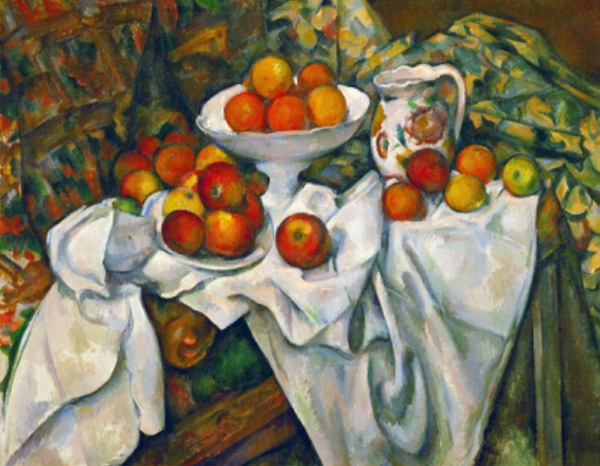Think about images that stay with you.
Here’s one of mine. I remember a framed Cezanne print that hung in the dining room when I was growing up. It was a simple table setting called Apples and Oranges done in muted yet attractive colors. Under the table was a shadowy figure and I was always curious what that person was doing there. I found an air of mystery that tended to haunt me after playing back the image in my mind.
 Apples and Oranges available as a print here.
Apples and Oranges available as a print here.
Another was from the Philadelphia Museum of Art. It was an almost life size painting of a bedoin prince in white robes. He was adorned with jewels. The lighting? Exquisite! The rendering by the artist of the metal and details like the hair on his knuckles was stellar. I thought it was possible that I was just amazed by this art because of it’s size. Not true. Upon revisiting this art several times I am continually amazed by this piece.
 Moorish Chief at the Philadelphia Museum of Art by Austrian Eduard Charlemont
Moorish Chief at the Philadelphia Museum of Art by Austrian Eduard Charlemont
Oil on panel 59 1/8 x 38 1/2 inches (150.2 x 97.8 cm)
Photographs that captured your attention and keep coming back to visit in your mind. They usually have touched a cord inside of you for one reason or another. I believe that Paul Cezanne has given us twelve words and a thought process that will help us to create better, more memorable images. Start with the emotion and find a way to tell the story more deeply and people will find your images more memorable.
How to get the emotion into your image? I suppose it depends on the emotion you are trying to elicit in the viewer. Happy, sad, love, jubilant, sad, placid, agitated, angry, frustrated (don’t ask flight attendants at the end of a four day run for emotional words)
A quick trip to Wikipedia say about emotion: …Emotion is a subjective, conscious experience characterized primarily by psychophysiological expressions, biological reactions, and mental states. Emotion is often the driving force behind motivation, positive or negative.An alternative definition of emotion is a “positive or negative experience that is associated with a particular pattern of physiological activity.”
I find that images that have shadows have more depth and tend to strike a cord more deeply than those that are brightly lit. Bright colors elicit energetic thoughts. Bright colors with wonderful shadows are even more powerful. Shadows with a soft edge transition tend to be more pleasing than high contrast shadows which tend to jar the viewer. Somber, muted, warm tone colors convey quiet.
The idea here is to begin to think of the emotion first then figure the best way to convey it. Now, how will I create a Tango image that shows all the power and grace of the movement??? Time to start thinking… thanks to Paul.

“A work of art which did not begin in emotion is not art.” Paul Cezanne





